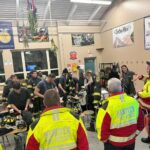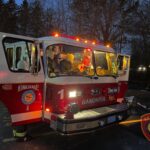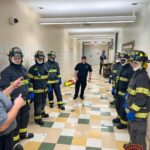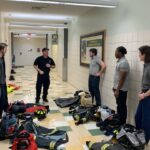Friends of Vocational Technical & Agricultural Education,
We are pleased to share another terrific example of collaboration between a regional vocational technical school and one of their district communities. A partnership developing as a result of a $40,000 grant through the Massachusetts Executive Office of Administration and Finance Community Compact Program awarded to the Hanover Fire Department.
Last week, Hanover Firefighters were at the South Shore Technical High School for the first night of the school’s new Fire Cadet Training Program. This program is a collaborative initiative between South Shore Technical, Hanover Fire and all other fire departments within the vocational school’s district to provide students with a basic orientation and familiarization to fire and emergency services. Twenty-one students from South Shore Vocational High School and several other area high schools began their eight-week journey into learning what it takes to be a firefighter.
We thank Keith Boyle, Director of Vocational Education, for sharing this with us.
David
The program will include topics such as fire department organization and management, fire and emergency services apparatus, equipment and facilities, fire department traditions and history, building construction, fire protection systems and fire prevention and community risk reduction. Students will also be provided basic first aid training as well as CPR training & certification. The majority of class time will be spent allowing students hands-on practical opportunities with items such as – fire department apparatus, self-contained breathing apparatus (SCBA), hose and hydrant introduction, ground ladders and hand tools. Guest lectures as well as field trips will also be included. Students are provided complete firefighting gear.
The first night focused on lectures highlighting fire department organization and management as well as a general orientation to the fire service and what steps are necessary to become a firefighter. Practical skills included turnout gear donning and doffing, self-contained breathing apparatus (SCBA) familiarization, hydrant use and a review of fire department pumping engines. The program is being operated similar to a firefighter recruit training program and a heavy emphasis is being placed on teamwork and accountability – two critical components of the fire service.
The program is made possible through a Commonwealth Community Compact Best Practices Grant obtained by the Hanover Fire Department. These funds allowed for the purchase of all supplies, equipment, gear, and instructor costs necessary for the eight-week program. The goal is to expand this orientation program into a fully developed training opportunity for high school juniors and seniors to obtain their firefighter and Emergency Medical Technician certification upon graduation of high school. This will provide the ability to jump start their career in the fire and emergency services.
David J. Ferreira
MAVA Communications Coordinator
DavidFerreira






